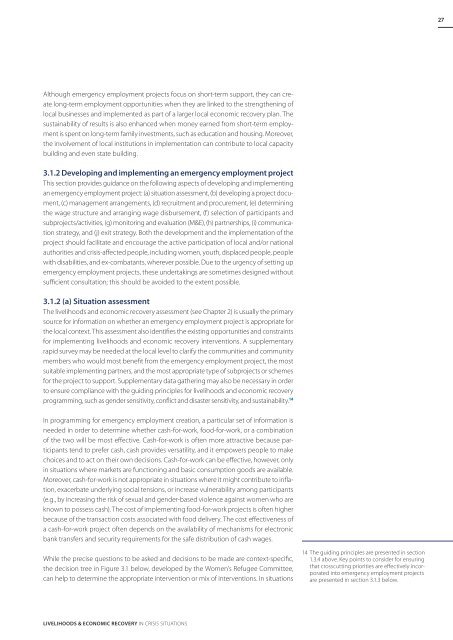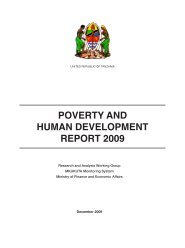Download PDF (4.08 MB) - ReliefWeb
Download PDF (4.08 MB) - ReliefWeb
Download PDF (4.08 MB) - ReliefWeb
You also want an ePaper? Increase the reach of your titles
YUMPU automatically turns print PDFs into web optimized ePapers that Google loves.
27<br />
Although emergency employment projects focus on short-term support, they can create<br />
long-term employment opportunities when they are linked to the strengthening of<br />
local businesses and implemented as part of a larger local economic recovery plan. The<br />
sustainability of results is also enhanced when money earned from short-term employment<br />
is spent on long-term family investments, such as education and housing. Moreover,<br />
the involvement of local institutions in implementation can contribute to local capacity<br />
building and even state building.<br />
3.1.2 Developing and implementing an emergency employment project<br />
This section provides guidance on the following aspects of developing and implementing<br />
an emergency employment project: (a) situation assessment, (b) developing a project document,<br />
(c) management arrangements, (d) recruitment and procurement, (e) determining<br />
the wage structure and arranging wage disbursement, (f) selection of participants and<br />
subprojects/activities, (g) monitoring and evaluation (M&E), (h) partnerships, (i) communication<br />
strategy, and (j) exit strategy. Both the development and the implementation of the<br />
project should facilitate and encourage the active participation of local and/or national<br />
authorities and crisis-affected people, including women, youth, displaced people, people<br />
with disabilities, and ex-combatants, wherever possible. Due to the urgency of setting up<br />
emergency employment projects, these undertakings are sometimes designed without<br />
sufficient consultation; this should be avoided to the extent possible.<br />
3.1.2 (a) Situation assessment<br />
The livelihoods and economic recovery assessment (see Chapter 2) is usually the primary<br />
source for information on whether an emergency employment project is appropriate for<br />
the local context. This assessment also identifies the existing opportunities and constraints<br />
for implementing livelihoods and economic recovery interventions. A supplementary<br />
rapid survey may be needed at the local level to clarify the communities and community<br />
members who would most benefit from the emergency employment project, the most<br />
suitable implementing partners, and the most appropriate type of subprojects or schemes<br />
for the project to support. Supplementary data gathering may also be necessary in order<br />
to ensure compliance with the guiding principles for livelihoods and economic recovery<br />
programming, such as gender sensitivity, conflict and disaster sensitivity, and sustainability. 14<br />
In programming for emergency employment creation, a particular set of information is<br />
needed in order to determine whether cash-for-work, food-for-work, or a combination<br />
of the two will be most effective. Cash-for-work is often more attractive because participants<br />
tend to prefer cash, cash provides versatility, and it empowers people to make<br />
choices and to act on their own decisions. Cash-for-work can be effective, however, only<br />
in situations where markets are functioning and basic consumption goods are available.<br />
Moreover, cash-for-work is not appropriate in situations where it might contribute to inflation,<br />
exacerbate underlying social tensions, or increase vulnerability among participants<br />
(e.g., by increasing the risk of sexual and gender-based violence against women who are<br />
known to possess cash). The cost of implementing food-for-work projects is often higher<br />
because of the transaction costs associated with food delivery. The cost effectiveness of<br />
a cash-for-work project often depends on the availability of mechanisms for electronic<br />
bank transfers and security requirements for the safe distribution of cash wages.<br />
While the precise questions to be asked and decisions to be made are context-specific,<br />
the decision tree in Figure 3.1 below, developed by the Women’s Refugee Committee,<br />
can help to determine the appropriate intervention or mix of interventions. In situations<br />
14 The guiding principles are presented in section<br />
1.3.4 above. Key points to consider for ensuring<br />
that crosscutting priorities are effectively incorporated<br />
into emergency employment projects<br />
are presented in section 3.1.3 below.<br />
Livelihoods & Economic Recovery in Crisis Situations





